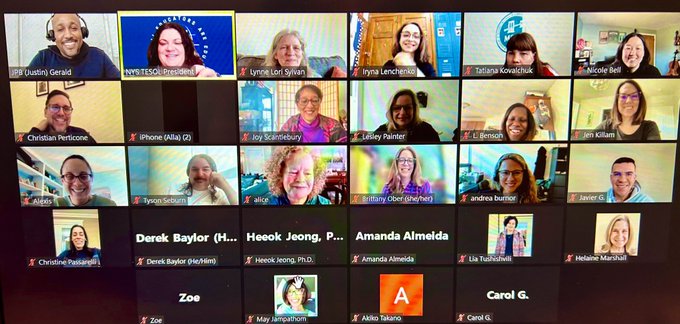Who doesn’t want to talk about race?
Back to BlogOur first Outreach event of the year was a successful one, with over 30 educators from around the state in attendance. On February 3rd, 2024 NYS TESOL and the Westchester Community College English Language Institute co hosted JPB Gerald‘s webinar “Overcoming Racial Discursive Buffers: How to talk about racism when no one else wants to (in TESOL).” JPB Gerald, well published author and Co-Chair of NYS TESOL’s Anti-Racist Action (ARA) SIG, provided a space to discuss the semantic moves and strategically managed propositions that colleagues, students, and supervisors use to safely halt honest conversations about racism (Bonilla-Silva, Eduardo, 2006). In Gerald’s words, “avoiding the topic (racism), while trying to stop you from talking about the topic.” Too frequently, these racial discursive buffers are used to divert or blunt conversations about the racism that diverse teachers encounter in the classroom and curriculum of their schools. Through open discussion, he encouraged webinar participants to relate their own experiences and rethink ways to have progressive conversations.

One stumbling block to honest conversation is the lack of a shared starting point acknowledging racial-linguistic ideologies, a paradigm Gerald described saying, “Essentially, language does not exist in a manner apart from the bodies or brains that produce it.” As such, the teaching of colonial languages, like English or French, has the process of racializing students, teachers, and curriculum embedded within it. To avoid this topic in professional conversation, he notes that colleagues and supervisors have responded, for example, to his disclosure of a micro aggression with, “I’ve also been discriminated against for accent,” and his observation that a faculty lacks racial representation with, “our team is very diverse,” meaning that there is gender equity. Without mentioning the word “race,” these discursive buffers serve to defeat the honest conversation that might lead to necessary actions, like restorative conversations or revised hiring practices.
A significant topic of discussion over the course of the webinar was addressing buffers that inhibit conversations about accent discrimination in curriculum. A statement in this vein made by Gerald’s former colleague was, “They’re going to need to use English like a native speaker to get any sort of job.” Participants brainstormed various responses that might be used to progress a conversation past a buffer like this, offering ‘You don’t think it’s good to show videos of (a successful non-native speaker) as an exemplar in class?’, and ‘I don’t know. There are 1.5 billion second and foreign language English speakers in the world, as compared to 400 million native speakers. Most professional English conversations occur between non-native English speakers.’ These responses align with three approaches that Gerald provided: ask questions, express confusion, and give everyone one chance. Some specific guiding phrases offered were, 1) I’m sorry, what did you mean by that? 2) I’m not really sure I agree. 3) Where did you hear/read that? 4) That doesn’t really feel right to me. 5) Did you ever think about why (insert systemic feature such as testing accent)? 6) I can’t really support that.
The distinction between race and culture, and the intentional blurring of the two, was another topic of conversation. Gerald noted the results of a simple survey he proposed to grad school colleagues in which he asked, do you teach about the connection between race and language in the classroom? In general, people do not. Some respondents dodged the question by stating, “I think it’s important to respect all cultures.” Culture is often used as a euphemism for race because culture has more positive connotations. Furthermore, recognition of culture in the ESL classroom is often reduced to “holidays,” and “heroes.” In making these distinctions with resistant colleagues, a participant noted, “It might be interesting to not only look at it in the immediacy of the moment but try to talk about the topic little by little, taking a generative approach.” To which, another participant noted, “I totally agree with that, and I think that I’m a really impatient person, but I’m trying to get used to playing the long game. A lot of these conversations happen at work, and these are people I’m going to see often.”
At the conclusion of the webinar, Gerald fielded questions and noted that these sorts of interactions are not easy, but he always tries to give the other person one chance. In asking a follow up question or seeking clarity, it is easy to tell who is genuinely invested in being better and helping others. The entirety of the webinar is well worth watching. It was consistently enlightening and entertaining, and Gerald created a space where all questions were welcomed.
Continue the conversation by listening to JPB’s podcast “Unstandardized English” and/ or joining the ARA SIG at ara@nystesol.org.
Feel free to reach out to reach out to JPB Gerald at justin.gerald22@myhunter.cuny.edu.
Black and neurodivergent - JPB Gerald is an adult educator who received his doctorate from CUNY – Hunter College in Instructional Leadership. He works in adult education and curriculum training at a nonprofit and is an adjunct professor in his spare time. His scholarship focuses on language education, racism, and whiteness, and he lives with his wife, young son, and dog in New York (on unceded Munsee Lenape/Canarsie territory). He hopes you will join him on the journey towards decoding and decentering whiteness in language teaching. Find his work at jpbgerald.com.
Reference:
“The Style of Color Blindness: How to Talk Nasty about Minorities without Sounding Racist”. Racism Without Racists: Color-blind Racism and the Persistence of Racial Inequality in the United States (2nd ed.). Lanham: Rowman & Littlefield)
Wrritten by: Christian Perticone
VP of Oureach, NYSTESOL
